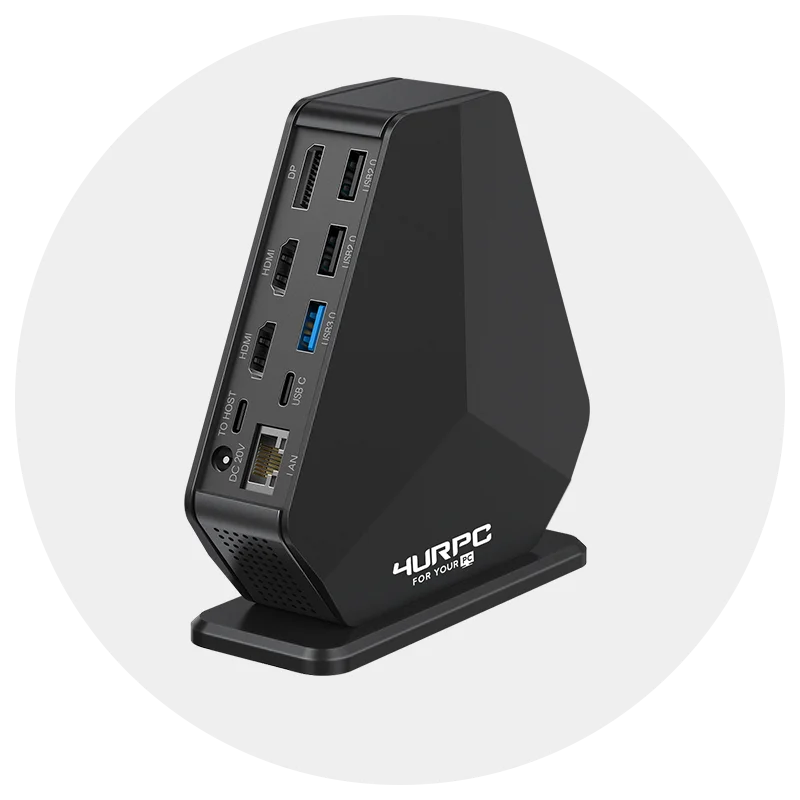In the past, many people have started using their laptops to embrace the work-from-home culture. However, due to the smaller screens of laptops, it's often challenging to achieve the same productivity as using a large monitor.
So if you are struggling to work from a smaller screen on your laptop, then this article is for you we'll show you the best ways to connect a laptop to an external monitor so that you can step up your productivity gain.
It's worth noting that working from home isn't the only reason why someone would want to connect their laptop to an external monitor many jobs require a multi-screen setup to boost overall productivity and maximize efficiency for instance. If you are a website designer or Photoshop editor, you could use the multi-screen setup to implement your edits on one screen and see real-time changes on another one. Similarly, video editors can use the multi-screen setup to color grade, their footage and see the results in real-time on the secondary screen.

Benefits of connecting an external monitor to your laptop
1. Multitasking with 2 Screens
The major benefits of why you would want to hook up your monitor to a laptop include that you can use two monitors to run multiple applications at the same time, and make use of multitasking more efficiently while working on presentations.
2. Dual-screen For Projects
Project reports the dual screen setup will protect you from tedious tasks of switching to, and from different tabs.
3. Gaming and Streaming
If you are a professional gamer or streamer, the multi-screen setup will uplift the overall gaming experience, and you'll be able to immerse yourself in the game.
Things to bear in mind before connecting your laptop with an external monitor
Before we talk about how to connect your laptop to a monitor, there are few golden rules that you must remember before setting up a multi-screen setup.
Firstly, check your laptop for all the possible output ports, in general laptops are equipped with three different display ports the HDMI port, the DisplayPort, and the USB type-c port. Based on which port you use you will be able to find and purchase the right cable accordingly.

How to connect an external monitor to the laptop?
While setting up two or more screens, it's important to specify the main display, and then the extra one for a streamlined operation and for you to work more efficiently you can achieve this goal by simply going into your display settings of your computer, and then setting up the main display.

We've covered the port now let's look at different ways to use an external monitor with your laptop.
Use an HDMI Cable
The easiest way to connect up an external monitor to your laptop is to use an HDMI cable, the HDMI stands for high definition multimedia, and it allows users to send and receive audio and video signals to different display devices the majority of laptops will come with a dedicated HDMI port.
If your laptop does have that port all you need to do is, just buy an HDMI cable and use it to connect your laptop to an external monitor, make sure that you are using the correct version of HDMI when connecting your laptop to your monitor and ensure that the monitor is set to the HDMI mode.
Use the DisplayPort
It may be possible that your external monitor or laptop doesn't have an HDMI port, but it might have a DisplayPort in this situation instead of using an HDMI cable. All you have to do is get yourself a DisplayPort cable to get the job done, your laptop should connect to your external monitor automatically, but again make sure that your monitor is set to DisplayPort mode and you have inserted the cable into the right port the same way you would have done for HDMI.
Use a USB Type-C Cable
Some modern day laptops and monitors though also come with a dedicated USB-C port. If your hardware configuration supports USB-C connectivity you won't have to use an HDMI or DisplayPort cable with a USB-C port on your laptop. You need to make sure that it supports DisplayPort over USB-C, you may need to contact the manufacturer of your laptop to check.
If the USB-C port is capable of this if it does, then you can simply buy a type-c to type-c cable, to transmit the audio video signals between your laptop to your display when buying a USB-C cable make sure to avoid USB 2.0 type-c cables. I would recommend at least a USB 3.2 gen 2 type-c cable also some monitors and laptops support thunderbolt meaning you will need to buy a specific thunderbolt cable. This will look identical to a normal type-c cable so make sure to check the specifications on the cable. Otherwise, you may lose some of your features with your thunderbolt monitor, or it may not work at all finally if you do not have an HDMI port, or DisplayPort.
Use A Docking Station or Adapter
You can use a docking station or adapter to transmit the video and audio signals between your laptop to your external monitor.
There are many different types of docking stations or adapters that you can use to connect your monitor to your laptop.
Firstly you need to find out if your monitor uses HDMI or DisplayPort, then you can then buy a matching docking station or adapter.
Recommend
HU-105 Docking Station Dual Monitor USB C Adapter

HU-104B Laptop Docking Station

DS-C05 Dual Monitor Laptop Docking Station

DS-C02 USB-C Triple Display Docking Station

Use a Displaylink
However, if your laptop doesn't have a USB C port, you can use a DisplayLink adapter with your USB type a port. A DisplayLink adapter uses a special piece of software to send to the adapter, which then converts that to an HDMI signal, you can also get a DisplayPort version.

If your monitor only supports DisplayPort, the only downside to this is that this will use some of your computer's processing power meaning if your computer is older and underpowered, then it might slow it down further depending on the resolution of your display. Also, these adapters can be a bit bulkier than a standard adapter, but it could be a great option if you have no other way of connecting to an external display.
So that's what you need to know on how to connect your laptop to an external monitor based on your hardware configuration of your laptop and the monitor. You can choose any one of these solutions to get the job done, so pick the right method and enjoy the benefits of a multi-screen setup.




